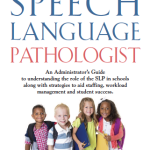SLP Chat
This will be a place where therapists can share ideas, problem solve and express concerns. Lets work together to make our jobs easier!
Teresa
Never miss an opportunity to learn from another professional
College can give you a good foundation but the real learning comes once you start working. And if you’re smart you’ll learn from everyone you work with, colleagues and clients.
When I started working in early intervention 20 some years ago, I knew little about child development, family issues or caseload management. So I faked it for awhile until I was able to watch, listen and learn. Luckily it was a job where we talked and consulted a lot. We did arena assessments where one person facilitated and the rest of us observed. I was able to watch, listen and read the final reports of all professionals involved. Now that I look back I was lucky to find a first job where people really respected what you had to say and at least considered your recommendations.
During those years I watched and listened not only the other speech therapists on staff but the physical therapists, occupational therapists, nurses and social workers. The information I gathered in those two years has served me well throughout my years of working in the public schools. The biggest lesson I learned in Early Intervention was to always listen to what other people have to offer, consider their view point and if the information makes sense use it or at least remember it.
These days it pains me when I sit in team meetings and see no one taking a note as the school psychologist gives her report and recommendations, I want to stand up and yell “Write this down, this is good stuff, it will help you understand the students learning style!” In team meetings it isn’t just classroom teachers that need to take notes. If principals and vice principals were smart they would be taking notes too, so when an issue arises they can refer to the notes when dealing with special needs children and parents. When you sit in a team meeting as a passive member you are missing out on a learning opportunity. Not to mention when you also look passive or even uncaring to the parents.
Within the public schools, services can often seem so fragmented. The team meeting is one of the few scheduled opportunities to listen to and collaborate with your colleagues. Beyond that there is often little time to consult with others working with a student. However, another thing I noticed is that everyone is often on their own agenda, “only do what I have to do with the student to achieve my goal.” When you walk into a classroom and see none of the recommendations that specialists have suggested in place, you have to wonder if the teacher was listening or even considering making changes.
More than likely four things may have happened that keep the teacher from implementing accommodations, either the teacher was not present when you made recommendations in student meetings, the teachers did not even take note of your recommendations, the teachers are so overwhelmed with what they have to do it’s impossible to carryout or remember even the simplest accommodations or they have little understanding of the child’s disability or needs.
I have worked in schools where they made the teachers an important part of the meetings (hiring a sub so they could attend) and in schools where teachers buzzed in said their piece and buzzed out. When the school allows or even requires the teachers to stay in team meetings they have a much better understanding of the specialists roles and recommendations. How can you expect teachers to understand a child’s disability or unique learning style when they weren’t even there to learn from the specialists. If I was the parent I would either question or at least wonder why my child’s teacher is not present to hear this valuable information.
Like I mentioned above. I’ve sat in many meetings where not one person (other than myself) is taking notes on what any the specialists have to say, nor did they take a copies of the reports. What does that say. It says they are not taking the opportunity to learn from another professional. When learning from other professionals isn’t encouraged, it not only disrespects everyone involved but in the end the child loses out.
Meet the SLP Bloggers II
In an effort to expose readers to the wonderful SLP and educational bloggers out there, Teach Speech 365 came up with a creative idea for a “Chain Letter Link-Up.” You can read all about me at Lets Talk Speech and Language.
Now it’s my job to interview my second blogger. This interviewee is Jessica Chase of Consonantly Speaking,
Please take the time to check our Jessica’s site, she has some great information to share.
1. Jessica Chase, M.A. CCC-SLP, Consonantly Speaking – http://consonantlyspeaking.com, consonantlyspeaking@gmail.com
2. When and why did you start blogging?
I started blogging in March of 2012 because I had a lot of great ideas of therapy activities that I wanted to share. I had previously written a movie review blog and wanted to try my hand at something in my profession. My main goals were to share information and collaborate with other speech-language pathologists.
3. What is your favorite population to work with?
I love working with the school-age population and in particular fluency disorders (cluttering especially).
4. How much time per week do you spend blogging and/or creating materials?
I think that the amount of time I spend blogging per week varies due to the fact that I try to have a social life in the evenings/on the weekends, plus I have a full time job/wedding to plan. If it is a slow week for me, then more posts are going to pop-up. If it is a busy week, you may not see me on the blog as much but moreso on Pinterest and Facebook. In addition, many of my blog posts are in-depth, lengthy, and involve lists that I take months to complete. I really like to take my time and make sure I have all of the information.
5. What’s your favorite topic to create materials for?
I have only created one material so far, other than my app/book lists. I think once I get into the material-world I will focus a lot on fluency, vocabulary, and auditory processing since that is where I have the most clients (other than articulation).
6. What’s the best thing about blogging?
I would have to say that the best thing about blogging is collaboration. I get to hear other SLPs thoughts on my posts and materials. I also get to learn a lot from them that I can take back and use with my students.
7. Do you have any blogging tips?
My biggest blogging tips involve content, audience, and self-promotion. Post a lot of content (not necessarily materials or reviews all the time) and it will keep people coming back for more. They will notice that you are an expert in your field of study and come to you with questions, collaborative ideas, and more. Also, think about your blogging audience. If you work with a 0-5 population and post about your experiences with early language development, you are going to get followers who are looking for information on that population or who have children in that population. If you deviate from your audience, they most likely will not return. Finally, do not focus so much on self-promotion. It will annoy your readers and they may not stay in the long-term.
8. How did you know that you wanted to be a speech-language pathologist?
Are you really a co-teacher or just a glorified aid
ATTN: Now please understand I don’t mean to ruffle anyones feathers with this article. I know there are a lot of therapists who don’t agree with my position. If you have a co-teaching model or push-in therapy model that really works for your student, not for you, your schedule, your high numbers or your administration, please share it in the comments section. Please share not only your model but how the model evolved and your caseload. I base my perspective on my experiences and those who have shared their experiences with me.
The past 10 years or so there has been a big push for therapists to use a co-teaching or push-in model. I have no clue where this idea came from and I don’t feel like doing the research. I honestly think one morning someone (who does not work directly with kids) woke up and said wouldn’t it be great if the speech therapists saw their students in the classroom.
On the surface that sounds like a great idea. You have a speech language pathologist come into the classroom, imagine what they could offer. An actually if it was a true co-teaching model where the speech language pathologist worked in tandem with a classroom teacher, they planned together, delivered lessons together and evaluated the students together, that could be great. What has happened, is that therapists are being asked to provide in-class services, either planning a class activity for that time or just going in and hoping they can somehow integrate themselves into the class for that one half hour a week. On paper that too is called co-teaching (apparently co-teaching on paper looks good to the powers that be). Oh did I forget to mention that in some situations therapists are expected to do this in every single classroom.
The problem I have always had with therapists as co teachers is that we are usually told “just do it” without any regard for the student’s needs, a lack of understanding of our level of expertise, a lack of respect for what we can realistically offer, a lack of co-planning time, scheduling constraints, teachers that aren’t willing to coordinate, no planned way to measure effectiveness and no training. I have never felt that I have been able to offer my language disabled students the level “therapy” they need in the classroom setting. Never have I worked in a organized co-teaching model.
There have been times when the teachers not only ignored me in the classroom but ignored the fact that I am there to work with or at the very least observe particular students. With that said there have also been some wonderful teachers who will switch thing up a little when they see me come in to accommodate my limited time. Even with accommodating teachers, without sufficient planning and evaluation time, a therapist going into a classroom is usually no more than a glorified aid. Being a glorified aid makes my job very easy. There have been times when I have only had one or two direct or indirect interactions with my student during my 30-45 minutes in the classroom. That hardly gives me time to address or observe my goals and objectives.
I don’t really think the disconnect is so much between the teachers and the therapists, most of us are willing to learn new methods, if they’re effective. I believe the problem lies between the administration/school board and their lack of understanding about how schools work, special education and how children learn. It somehow sounds better if a school says they use a co-teaching model. Most people don’t understand how loosely that term is used.
Here is a link to 6 different types of co-teaching models. http://faculty.felician.edu/caseyb/Types%20of%20Co-Teaching%20notesheet.doc. Take a look at it and see where the services at your school fall. I can’t cite the author because there isn’t one. Another site claims 5 co-teaching models http://trailblazers.wikispaces.com/file/view/co_Teaching_Models-W.pdf. I guess my point is even people who feel strongly about co-teaching haven’t decided the best way to go. Again no author cited.
I was a huge fan of co-teaching when it was first introduced 20 some years ago. However, most schools have never been able to put in the time, energy or resources necessary to make it work. So my observations conclude that kids often miss out on valuable “therapy” time, when services are delivered within the classroom setting. That’s not to say that when they are ready to integrate newly learned skills that they can’t benefit from some services provided within the classroom setting. (then we get into scheduling issues so lets not go there).
Speech language pathologists really need to look at their overall effectiveness within the classroom setting. Are the student’s need being met? That’s the key question. If your answer to this is “no” then congratulations, you’ve become a glorified aid.
Games Can Be Fantastic Therapy Tools
I have always said that I can turn or modify any game into an educational experience. Me at my advanced years was thinking only about board games. Over the years I’ve been able to teach almost every single language skill through conventional games. Unfortunately, those days are numbered because it’s hard to collect data when your having fun.
I was extremely pleased when I came across this article on Geekslp.com Angry Birds Educational Tool. This article truly validates what I already know. I am so glad the younger generation of SLP’s are able to see the value of games in learning. I love angry birds but never even thought to bring it into my therapy as a tool but I have used it as a reward. Why I never thought of this I don’t know. This article presents an excellent perspective and shows just how creative speech language pathologists can be.
Reality is kids just don’t know how to play anymore. Our students are usually at an even bigger disadvantage for knowing how to initiate play with others, feel successful and how to accept wins/losses gracefully. Anytime we play a game with our students we are providing a learning experience that they will not get from their peers or even their parents.
I actually have a whole section on my blog called Modify that Game, which I will admit is dated with it’s information. Still the point is there, games can have educational value.
My last article on gaming was back in June.
I was following up on an article a friend sent me. Basically I said that video games are good but you would still need a skilled teacher to fill in the gaps. I’m not a video gamer so I reserved making any harsh judgements.
However, I was writing about the importance of play long before that. The Importance of Play
I am still amazed at the number of children I encounter that truly don’t know how to play and I’m not just talking about our language disabled kids. Kids are so managed these days that they are loosing their negotiation skills, critical thinking skills, imaginations, flexibility with interpersonal skills and play skills.
Recently an SLP contacted me to tell me that she was not allowed to use games in therapy any more. I thought how sad that we’ve gotten to the point where fun had to be squashed in order to make sure kids pass a test or that enough data gets collected. I figured that was the reason or that their administration was nuts.
Enjoy the articles highlighted above, put a little bit of fun into your therapy setting, worry about data collection around progress report time. Modified games can play a huge role in therapy not to mention increase motivation. Funny that it’s more accepted if the games are presented on the computer or iPad that out of a dusty old box. However, games are much easier to modify out of the dusty old box. Personally I can see the value in both conventional games and some computer games/apps. Just like conventional games and therapy games, there are a lot of junky computer games and apps that are not worth even trying out.
Meet the SLP Bloggers
In an effort to expose readers to the wonderful SLP and educational bloggers out there, Teach Speech 365 came up with a creative idea for a “Chain Letter Link-Up.” You can read all about me at Lets Talk Speech and Language.
Now it’s my job to interview 2 other bloggers. Today I traded e-mail’s with Jocelyn Kupperman, who writes informative blog called “Ms. Jocelyn’s Speech”. Ms. Jocelyn also uses her expertise and talent to create materials for Teachers pay Teachers. Please check out her site and materials.
http://www.
I started officially blogging in October of 2012. I love to collaborate with colleagues and other education professionals to stay up to date with the best teaching and therapy methods. I have found a lot of inspiration from blogs and websites in the past and wanted to pay it forward by sharing lessons and tips I find successful in my practice.
5. What’s your favorite topic to create materials for?
6. What’s the best thing about blogging?
7. Do you have any blogging tips?
8. Add a question and answer of your choice (can be speech related or not).
PPVT vs. ROWPVT Survey Results
This was an easy survey to interpret. About 80% of the therapists who responded use the PPVT and EVT combo to assess vocabulary skills. 15% are using the ROWPVT/EOWPVT combo and 5% reported using neither.
The most common response for choosing a test is because that’s what is available. With therapists moving around so much, you are usually in a position where you are using tests chosen by another therapist. Sometime the administration thinks they know better and buy the ROWPVT/EOWPVT combo because it is significantly less expensive.
No one gave any praise for the ROWPVT/EOWPVT combo but those who use the PPVT/EVT combo felt that it was reliable and give s a good overall representation of the students ability.
One person who wrote neither followed up with the following comment. “I work in a low SES school and have found that too many students score low on vocabulary measures. Low vocabulary scores reflect more on their home environment than whether they have a true language disability. A large portion of our school is also ELD.” I think this presents an interesting dilemma. I certainly understand this therapists position having worked in that type of school on a small scale. Now the school I worked in was big on developing vocabulary. However, what I noticed is that the children were being taught higher level vocabulary words without knowing a lot of lower level or basic vocabulary words. Body parts were a perfect example, most of my students did not know their smaller body parts in either language. Kids did not know word relationships or simple ambiguous words. Interestingly enough school I worked at is now using the PPVT/EVT combo as a screening tool as part of some state program. I like the idea of it but people with very little training are administering it so I of course question the reliability of the results.
Basically the PPVT/EVT combo wins as therapists choice. It’s my choice too usually but I have to admit, I’ve used the ROWPVT/EOWPVT a couple times recently. I used it either because it was quick or it is what the child had during previous testing 3 years before. It bothered me a little but no one else seemed to mind. I don’t have the comfort level with it or the experience to view it as a reliable measure. I do feel the updates they made to it have improved the test though.
Shattered
Schools I feel do their best to make their schools secure but honestly most fall very short. In most schools there is a sign that says visitor have to check in with the office. Some schools do lock their front doors and you have to be buzzed in. Visitors are often buzzed in without verbal confirmation of who they are by untrained and very busy office staff looking at a 6×6 screen. It’s also very easy to piggyback into the school if there is a person in front of you. In no school that I have ever worked in was there a locked door between the office and the rest of the school. Basically once someone is in a school they could go anywhere.
Newer schools might have a better set up with cameras and newer security systems but older schools just were not designed anticipating this type of concern. Schools were designed to make it easy for staff and students to access the office.
When I first started teaching all we ever had to practice is fire drills. Today that’s a no brainer, you line up the kids and take them outside. Lockdown procedures began for me about 5-6 years ago. I took this seriously but also knew that they fell far short of really being able to protect children. To initiate lock down an announcement is made. Hopefully, a teacher is actually able to hear and attend to the announcement. I could also see situations where the announcement could not get sent out. We were asked to use our own cell phones incase of emergency, then told to slip either a green or red card outside our locked door to tell them if we were ok or not. To me that was like saying “here we are.” One day we had a power outage and the principal asked me to go around and ask the teachers to turn on their cell phones so they could be contacted, well over half either had no power or left them in their car. Another school I worked at in an urban area as recently as 2 years ago didn’t even know what I was talking about when I asked about their lock down procedures. Even something as simple as everyone having a good functioning room key to lock doors is often a complicated procedure in school systems. Security seems to depend greatly on the beliefs and efforts of the school system and local law enforcement.
Sadly it is doubtful that anyone other than law enforcement could have stopped this monster from getting into the school and killing these children. If he didn’t have access to guns he would have found another way. In the days to come we might find out why he did this or if he was showing any behavior that could have indicated he was capable of this. Was this a planned or spontaneous act. Is it even going to matter unless we are able to identify these individuals and intervene. Is that even possible?
Every school system in America is thinking about how they should improve their school security this morning. I’m almost sure that in the long run little will be done to make schools safer. Schools will talk about it at every school committee meeting, some will hire consultants, a few will put new or updated procedures in place, a select few will actually make the expensive changes needed that will actually be somewhat effective. Part of the problem with this is that most communities do not want to believe something this tragic can happen there. Especially communities where many don’t even feel they have to lock their doors. Administrators with no security training or never having even experienced living in areas where crime is an issue are not equipped to make security decisions or plans. Law enforcement needs to step in and design the security for school buildings. In many situations I am not confident that local law enforcement will even take it seriously enough.
I can’t even imagine the grief Newtown Ct. is feeling today. This is no doubt a parents, teachers, first responders, community and even nations worse nightmare come true. My condolences and prayers go out to everyone directly effected by this horrible tragedy. I am so sorry this happened.
Survey Says! Results of Entrance and Exit Criteria Survey
Well only 5 people responded to this survey. I can conclude three things from that. Either it isn’t as big of an issues as I thought (or hasn’t become one yet), the survey was too long or no one is looking at my blog. More than likely it is the last one. Even though it was only 5 people responding I received some very interesting feedback that I would like to share and comment on.
The basic question was…..Does you school have entrance and exit criteria? Only one out of the 5 respondents said they had entrance and exit criteria. Apparent this was done in an attempt to standardized services throughout a very large school system. They went on to say that it was put in place in 2011 after a year long study by a group of SLPs. Their criteria was based on state law and ASHA guidelines. Basically they see students who fall in the 7th percentile or lower up to age 8, then 2nd percentile or lower after that. They are also able to use their professional judgment in some situations. Based on the responses from this therapist I was under the impression that these guidelines were working well in their setting. However, the therapist commented that she wished that she could serve the students that score much higher and be closer to private therapy standards.
I was actually glad to hear that one person out there was happy with the guidelines set up by their school district and that speech language pathologists actually put the guidelines together. I think they probably developed guidelines that work well in a large urban setting. Using percentile rank is interesting. It is more difficult for people unfamiliar with statistics to understand percentile rank. Kids functioning at the 7th-2nd percentile rank are really low, the standard scores on any of our tests reflecting those percentile ranks would be in the just below to below average range and age scores would be years below. I could hear the parents in our meetings now, “My kid is below average but not below average enough?” I am not totally sure if the same guidelines would be accepted in more suburban communities.
That statement about wishing she were able to service students closer to private therapy standards made me think. And I believe this is the crux of the conflict for me. I know we are a public school, we have to compromise on groupings, time, scheduling and caseloads are huge but should we as school therapists strive for a different level of service than a private therapist? Shouldn’t school therapies in general strive to be as good if not better than private therapies? Shouldn’t our goal focus be the same.? Shouldn’t the administration support this? This is an issue I will have to delve into another time because there is history here.
Over half of the respondents said that entrance and exit criteria has been questioned in their school. I’ve worked in many schools and in at least one meeting a year the special education director or some other administrator mentions developing E and E criteria. Their motivation of course is to see numbers go down. The development of the criteria never happens. I feel this is basically because we’re not give the time to do look at this issue critically, research and study. I also think this is a next to impossible task because our special needs students are so different. Most of us seem happy using the guidelines set up on formalized testing to aid our professional judgements. Any way wouldn’t we? We put our trust in tests that have been through trials and have the data to prove it. In this data driven world, therapists and educators have become notorious for creating their own measures to collect data which could or could not be consider reliable and valid.
In schools we also have that pesky guideline of wether or not the student is making effective progress. That is a double edge sword and makes writing recommendations/accommodations/modifications tricky in an evaluation report. The student may score poorly on many measures but is making effective progress (or passing the state mandated testing because lets be honest that is all the kids need to do these days) or the student may score in the low average or even high average range, exhibit other behaviors or an atypical manner of performance that impact learning/social skills but still making effective progress in academics. Then we have those who are not making effective progress with low scores (and not passing state testing). The first two kids don’t get picked up but the last one does. I think we have lost our focus on who needs our language services because of this. This drives us further away from being able to address underlying language skills that effect learning and life and attributes to increasing our caseloads.
Sorry, I know I got off topic a little here. As you can tell I am passionate about this subject. Most of the therapists who responded would like to have some E and E criteria, the reasons stated included, to be on the same page as other SLP’s and to take the subjectivity out of decision making. One therapist was adamantly opposed to developing criteria based on test scores only, pointing out that in a school system we have to look at other factors when determining speech and language needs. This is very true, that’s where professional judgement come in.
No one was able to come up with the ideal E and E criteria. My survey was more skewed toward entrance questions. However, exit criteria is probably a bigger factor. How much therapy to give and when to discharge a student from therapy are the two main questions I’ve been asked over the years. In the old days discharging a student from therapy was easy. We could determine if the student was meeting their goals (yes we usually wrote more than one), functioning in the classroom, plateaued, not receptive therapy to therapy, not willing to work in therapy or just not getting anything out of it. We could sit down with parents and explain. With the new laws we can’t do that anymore. Every student has to be tested before we can discharge them from therapy. Lets face it, students with low language skills (maybe low cog too), no matter how much quality therapy they have over the years are never going to score really well on our tests. It is the rare student that does that. They will improve but like IQ scores their test pattern will likely not change. We can strengthen areas of language, work on transferring skills to natural context and give them strategies. Our students will always struggle with language or even just be a beat behind the rest of the crowd.
Here is the link to ASHA’s Admission/Discharge Criteria in Speech-Language Pathology. Like most ASHA documents it is pretty basic. Maybe it has to be. After all it has to be a one size fits all document. It also leaves a lot of room for professional judgement. It also appears a little dated considering how much service delivery in the public schools has changed since 2004.
I asked a question about push back from administration when they didn’t like your recommendations. Half of the therapists said they have received push back from administration an one time or another. I was glad to see it wasn’t more. No one eluded to this being a chronic problem. It hasn’t been a huge issue in my career with only a couple of incidences over almost 30 years.
Sorry, I wasn’t able to draw any big conclusions or share any good information. I don’t know if there is an answer to the question of Entrance and Exit Criteria. Caseloads are growing and a lot of kids are qualifying for services. Why is this happening? We have been using the same tests for years. If more kids are qualifying using these tests than they did 10 years ago well then something else is wrong. Personally I think it is more a reflection of our society and lack of a good basic consistent curriculum in schools. Also our hands are really tied when it come to Exit criteria. It is almost impossible to discharge a student these days. Every year I pick up more than I discharge.
When it comes to developing entrance and exit criteria be careful what yo uwish for. I am not sure that we want administrators, who don’t understand what we do, telling us who to pick up and who not to pick up. It could happen. I don’t want to pick up kids just they are not passing a state mandated exam. I don’t want to pick up the slack for poor curriculums, void of phonics, critical thinking and I believe memory tasks. I don’t qualify kids so I can go into classes for a 30 minute session with less that 10 minutes of direct intervention. I do want to work with students who need specific help developing the underlying language skills they need to access the curriculum on their own. I do want to teach language strategies to aid overall success. I do want to introduce students who need it to higher order language functions. I don’t have faith that specific Entrance and Exit Criteria will allow me to do that. Although I would like to be open minded about it so if you feel your school has very good entrance and exit criteria please share.
One final thought:
The last question on my survey drew the most response. Do you feel too many students are qualifying for speech and language services? Why do you think this is happening? Here are the response verbatim.
1. Yes, this is happening at all levels. With little ones they’re picked up too soon for language and learning issues that they are not developmentally expected/or ready to do, curriculum does not address many important and higher level language areas any more so kids get little practice of skills and do not know how to apply them. Also teachers and administrators do know what we do or how we do it.
2. Yes. I don’t feel many of the students truly have language disabilities. I feel that they have low language skills, the curriculum is more demanding, the teachers have less time to work with the students, the background knowledge and overall language experiences of the kids have affected their language development. In my district, whether they test low or not, we are told to start dropping kids after grade six. They tell us to figure out a way to make it happen. I thing the overall need for kids with autism an Aspergers is definitely growing……… And the tests we have for them stink.
3. I think we qualify too many ELL students. Our district needs to work harder to
appropriately assess them and identify language differences versus a language disorder.
4. I feel like too many students are staying on the caseload in upper grades….middle school and not being exited despite scores not changing by the time of their 3year re eval. I think some SLPs are more LD based and service kids differently than others. Idk if this is right or wrong. I struggle in this area.
5. Yes… so many more children seem to appear to be \”on the spectrum\” with language concerns.
I have to admit this survey raised more issues and questions for me to ponder. Thanks to everyone who took the time to respond.
Topic for December
During the month of December The School Speech Therapist will be focusing on consulting and co-teaching. Any ideas, questions, concerns or thoughts on this topic I’d love to hear from you.
I will continue to follow up on the surveys around entrance and exit criteria and vocabulary testing. Just waiting for the data to come in. So if you haven had a chance to take a couple of quick surveys I’d really appreciate it.
https://theschoolspeechtherapist.com/ppvtevt-vs-rowpvteowpvt/










